Prediction System for Diagnosis and Detection of Coronavirus Disease-2019(COVID-19):A Fuzzy-SoftExpert System
Wencong Liu,Ahmed Mostafa Khalil, Rehab Basheer and Yong Lin
1School of Science,Xi’an Technological University,Xi’an,710021,China
2Department of Mathematics,Faculty of Science,Al-Azhar University,Assiut,71524,Egypt
3Department of Mathematics,Faculty of Science,Assiut University,Assiut,71516,Egypt
4Respiratory Department of Nanjing Chest Hospital Affiliated to Southeast University,Nanjing,210000,China
ABSTRACT In early December 2019,a new virus named“2019 novel coronavirus(2019-nCoV)”appeared in Wuhan,China.The disease quickly spread worldwide,resulting in the COVID-19 pandemic.In the current work,we will propose a novel fuzzy softmodal(i.e.,fuzzy-softexpert system)for early detection of COVID-19.The main construction of the fuzzy-softexpert system consists of five portions.The exploratory study includes sixty patients(i.e.,forty males and twenty females)with symptoms similar to COVID-19 in(Nanjing Chest Hospital,Department of Respiratory,China).The proposed fuzzy-softexpert system depended on five symptoms of COVID-19(i.e.,shortness of breath,sore throat,cough,fever,and age).We will use the algorithm proposed by Kong et al.to detect these patients who may suffer from COVID-19.In this way,the present system is beneficial to help the physician decide if there is any patient who has COVID-19 or not.Finally,we present the comparison between the present system and the fuzzy expert system.
KEYWORDS Coronavirus disease-2019(COVID-19);fuzzy-softexpert system;fuzzy expert system;diagnosed results
1 Introduction
In early December 2019, a new virus named “2019 novel coronavirus (2019-nCoV)” appeared in Wuhan, China.A novel epidemic disease (named “coronavirus disease-2019 (COVID-19)”) was announced by the World Health Organization (WHO) on February 11, 2020 [1].Also, the WHO described that COVID-19 is of origin.It is transmitted between animals and humans[1,2].Moreover,WHO showed that COVID-19 is the source of the disease as a severe acute respiratory syndrome in the Middle East [1].The latest statistics showed that the number of cases of the disease reached 3,152,556 cases, 964,840 of which were recovered and 218,491 deaths, while the number of patients currently infected is 1,969,225, of whom 1,912,345 are in stable condition and 56,880 are in critical condition[3].
Newly, research works on COVID-19 are very active and developing rapidly: The relationship between the severe acute respiratory syndrome coronavirus 2(for short,SARS-CoV-2)and COVID-19 was discussed [4].Characteristics of human coronaviruses (COVID-19 infection) were presented[5].COVID-19 was discussed as belonging to other coronaviruses and it was from the platoon Bedside [6,7].Further, it was published that there are diseases that increase the weakening of the body’s immunity and the speed of the infection with COVID-19(for example,diabetes,hypertension cases,and cancers)[8].The relationship between COVID-19 and rheumatoid disease was shown and studied[9].The effect of COVID-19 on several diseases,such as dialysis renal histopathological and hemodialysis patients was studied[10,11].The relationship between epilepsy and fever COVID-19 and neurological convulsions in the human body were studied[12].COVID-19 is an unusual virus because it reduces the percentage of white cells in the human body,especially of the type lymphopenia.As for the rapid spread of the disease,there was a study that shows that infection with COVID-19 is possible not only through respiratory droplets,but also possible through urine or stools,and the fecal-oral route[13,14].On the other side,about COVID-19 and its relationship to climate,there was a study examining four climatic factors related to high and low infections:Temperature,Humidity,Wind Speed,and UV rays[15].On the other hand,a final review was undergone for the COVID-19 prediction models that identified and evaluated twenty-seven studies,that statistically described thirty-one models[16].
Recently,COVID-19 has become one of the most dangerous viruses spread in the world and is an inspiration of the first death.To reduce the prevalence of COVID-19,we must find some appropriate solutions to keep people safe,which is to inform people about the dangers of COVID-19.Therefore,early detection of this virus (COVID-19) should be done through the medical expert systems or the design of a matching medical diagnostic system for expert physicians.There are several expert medical systems developed in medical diagnosis to detect the seriousness of the diseases(see[17-38]).
The present paper is arranged as follows: The basic notions of this paper are introduced in Section 2.The structure of the fuzzy-soft expert system is explained in Section 3.Experimental results are discussed in Section 4.A comparison between the present system and the fuzzy expert system is presented in Section 5.Finally,the conclusion is given in Section 6.
2 Preliminaries
2.1 Fuzzy Set,Soft Set,and Fuzzy Soft Set
Definition 2.1(cf.[39-42]) For given setX, let 2Xbe the set of all subsets ofX, [0,1]X(resp.,[0,1]XI=([0,1]X)I)be the set of all mappings fromX(resp.,I)to[0,1](resp.,[0,1]X).Then each elementA∈[0,1]Xwill be called a fuzzy set onX,and each elementA∈2X×I=(2X)I(resp.,A∈[0,1]XI)will be called a soft set(resp.,a fuzzy soft set)onXindexed byI.
The trapezoidal fuzzy numbers(called fuzzy sets,is the set of all real numbers), whereand also(called fuzzy set), whereare used repeatedly in the present paper,are defined by
Example 2.2Suppose thatX={u1,u2,u3}be a set of three types of houses andI={i1,i2}a set of two parameters,wherei1is‘price’,andi3is‘size’.This situation can be described by the following soft set:
It can also be described more precisely by the following fuzzy soft set:
Definition 2.3(cf.[41,42])For two fuzzy soft setsA∈[0,1]XIandB∈[0,1]XJ,define the fuzzy soft set(called“OR”operation)by=A(i)∨B(j) (∀(i,j)∈I×J)(also can be written
Example 2.4(Continued from Example 2.2).Consider{A,B}⊆[0,1]XI,defined by
then
2.2 Five Symptoms of COVID-19
COVID-19 signs and symptoms may appear between 2 to 14 days after exposure to the virus.The data for our work in this paper is obtained from(Department of Respiratory,Nanjing Chest Hospital,China).We used the five important symptoms [43](Shortness of Breath (ShB), Sore Throat (STh),Cough, Fever, Age).The symptoms of COVID-19 can range from very mild to severe.Some people may never have symptoms.Older people or those with medical conditions,such as diabetes,heart and lung disease, or a weakened immune system, may be more likely to develop severe disease.This is similar to other respiratory diseases,such as influenza.So,we have considered the five symptoms in designing our system.
3 Methodology of Proposed Fuzzy-Soft Expert System
The fuzzy-soft expert system gives diagnostic assistance related to COVID-19 where the final results of the sixty patients will be discussed by specialist doctors.The basic construction of our system has five steps illustrated in Fig.1.As Fig.1,these five steps are explained in detail as shown below.
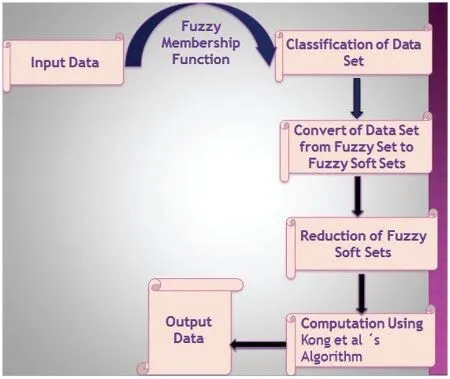
Figure 1:Main construction of fuzzy-soft expert system
3.1 Classification of Data Set
We will explain the classification of data set according to membership functions as follows:
(1)ShB:have four membership functions(Low (L), Medium (M), High (H), Very High (VH)),where the range of L is less than 25, M is in between 23 to 49, H is in between 37 to 60, and VH is greater than 49.Trapezoidal represents‘L’and‘VH’,also triangular represents‘M’and‘H’.
(2)STh:have four membership functions(Low (L), Medium (M), High (H), Very High (VH)),where the range of L is less than 35, M is in between 35 to 60, H is in between 47 to 75, and VH is greater than 60.Trapezoidal represents‘L’and‘VH’,also triangular represents‘M’and‘H’.
(3)Cough:have four membership functions(Low(L),Medium(M),High(H),Very High(VH)),where the range of L is less than 14, M is in between 11 to 48, H is in between 33 to 65, and VH is greater than 59.Trapezoidal represents‘L’and‘VH’,also triangular represents‘M’and‘H’.
(4)Fever:have four membership functions(Low(L),Normal(N),Moderate(M),High(H)),where the range of L is less than 36.4,N is in between 36.5 to 37.5,M is in between 37.6 to 38.3,and H is greater than 38.4.Trapezoidal represents‘L’and‘H’,also triangular represents‘N’and‘M’.
(5)Age:have four membership functions(Young(Y),Mild(M),Old(O),Very Old(VO))where the range of Y is less than 38,M is in between 33 to 45,O is in between 40 to 58,and VO is greater than 52.Trapezoidal represents‘Y’and‘VO’,also triangular represents‘M’and‘O’.
4 Experimental Results and Analysis
In the present work,we will give an exploratory study that includes sixty patients(i.e.,forty males and twenty females) with symptoms similar to COVID-19 in (Department of Respiratory, Nanjing Chest Hospital,China),where forty males:p1,p3,p4,p6-p12,p14-p20,p23,p25,p30,p32-p37,p45-p50,p52-p59and twenty females:p2,p5,p13,p21,p22,p24,p26-p29,p31,p38-p44,p51,p60.The data of sixty patients are illustrated in Table 1.
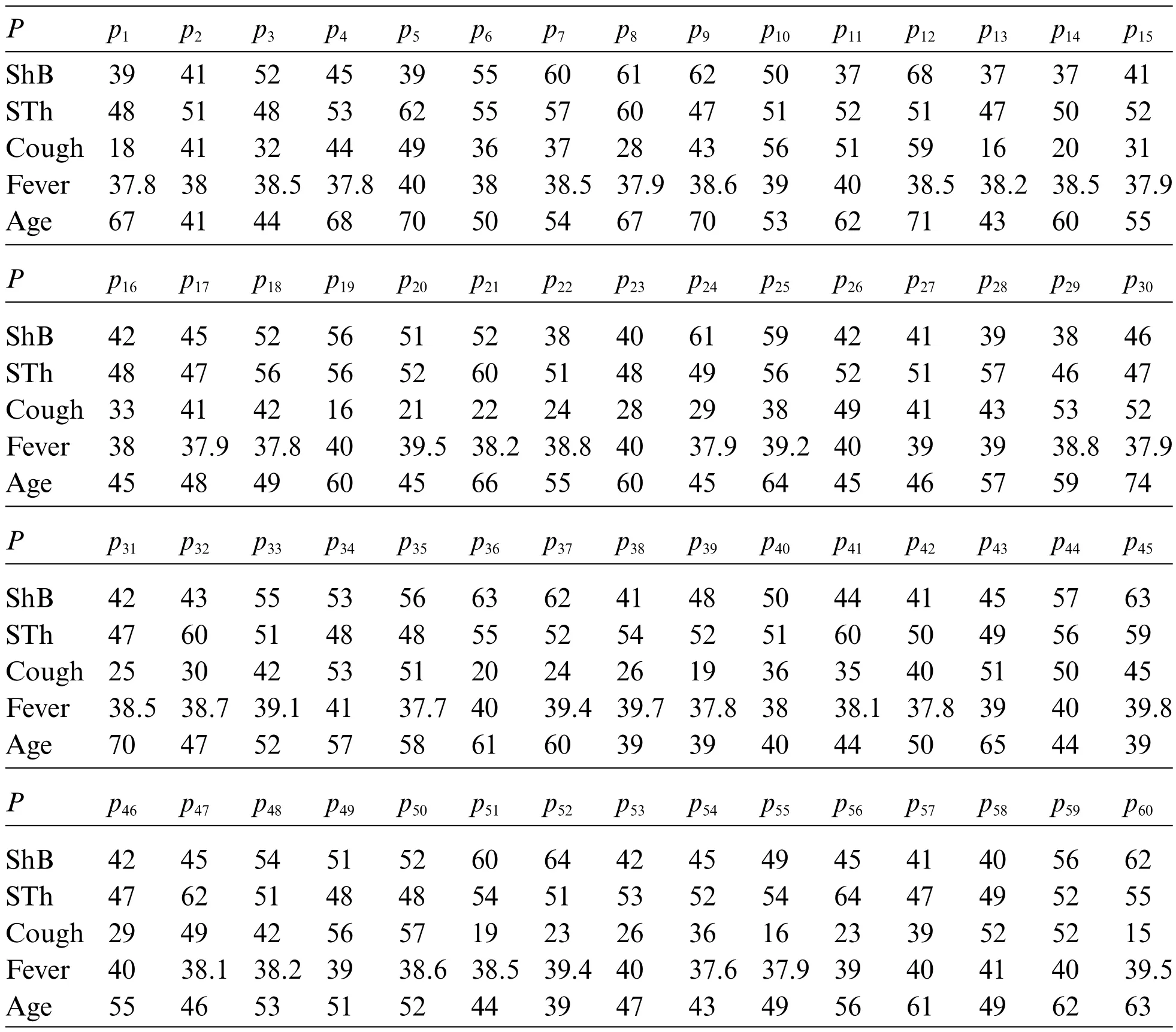
Table 1: Data of sixty patients
Next,we will get the membership functions of every patient(i.e.,forty males and twenty females)are illustrated in Tables 2-5.
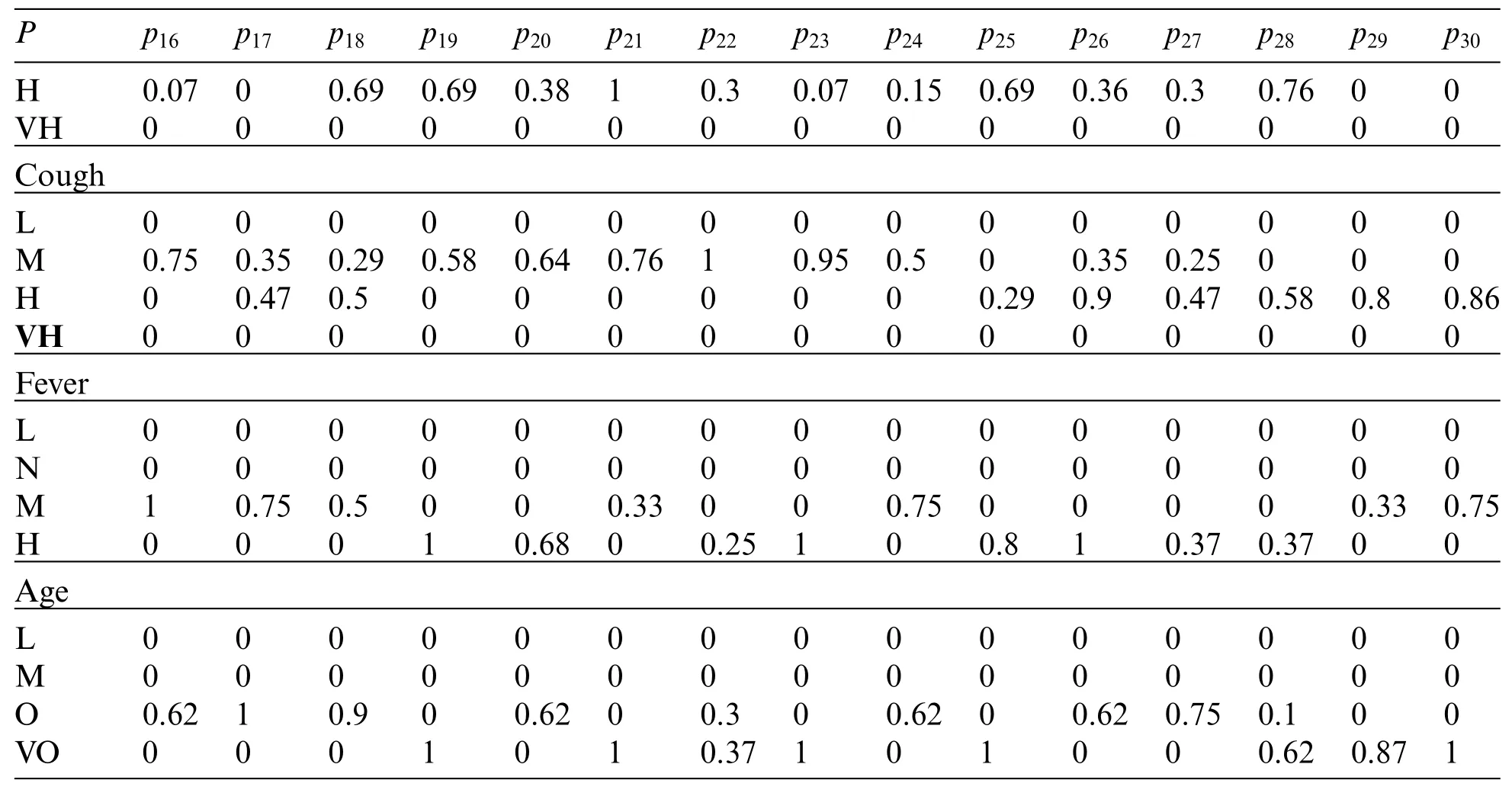
Table 3 (continued)
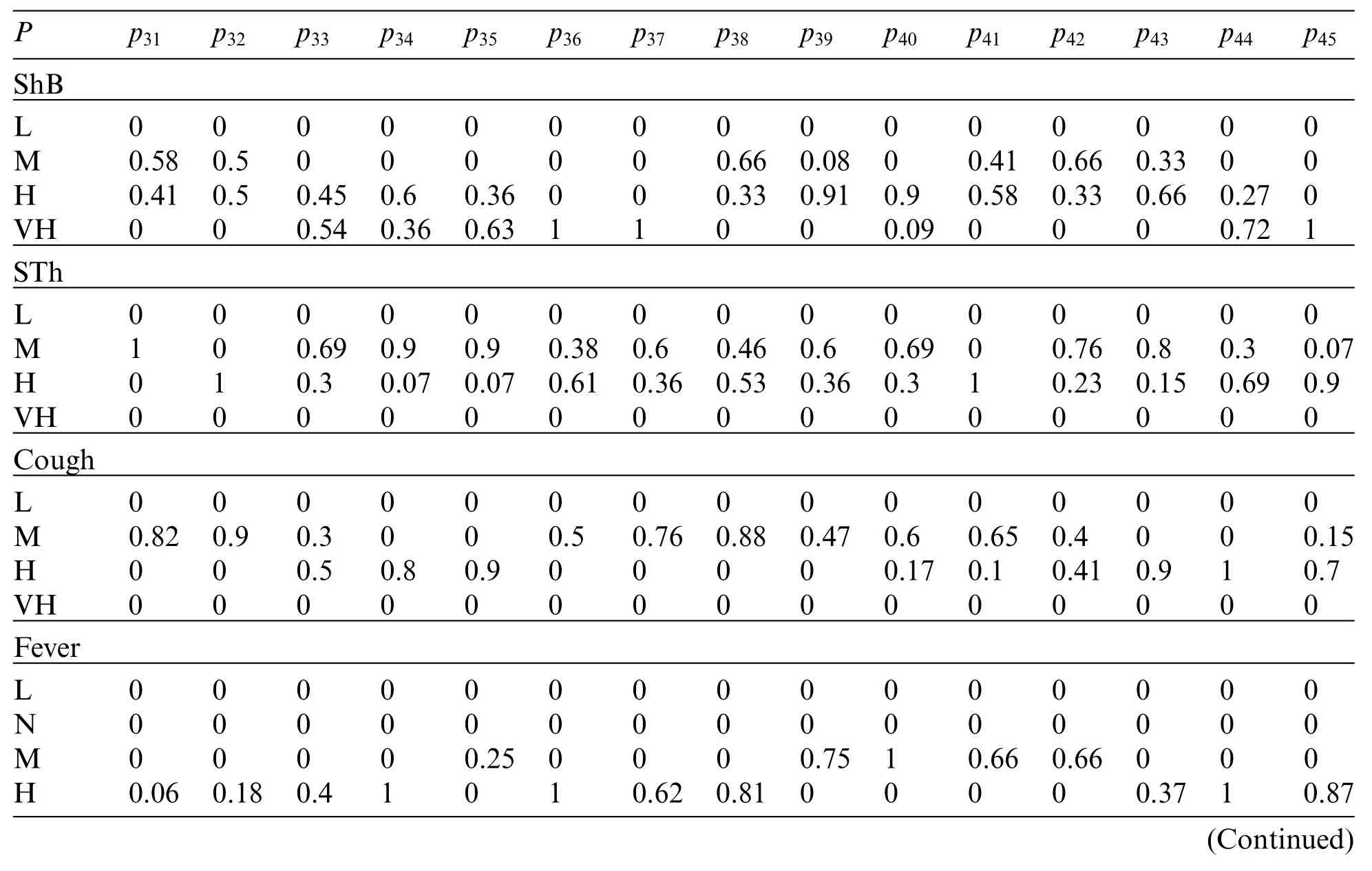
Table 4: Membership functions of patients p31-p45

Table 4 (continued)
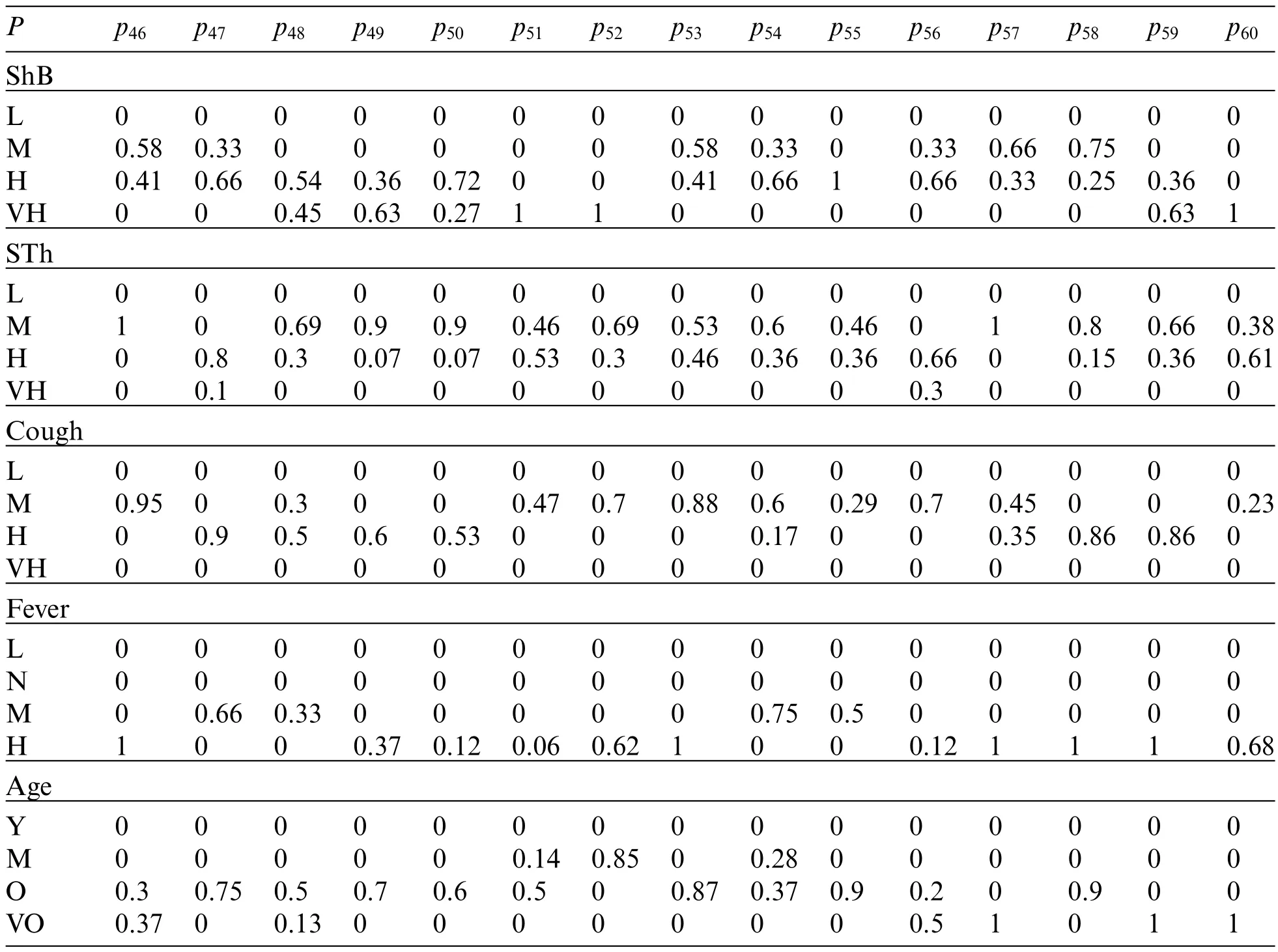
Table 5: Membership functions of patients p46-p60
4.1 Convert of Data Set and Reduction of Data Set
(1)Assume thatP=Pm∪Pf, wherePm= {p1,p3,p4,p6-p12,p14-p20,p23,p25,p30,p32-p37,p45-p50,p52-p59} represents the forty patients from males,Pf= {p2,p5,p13,p21,p22,p24,p26-p29,p31,p38-p44,p51,p60}represents the twenty patients from females,andbe the set consisting of 20 parameters as{ShB(L),ShB(M),ShB(H),ShB(VH),STh(L),STh(M),STh(H),STh(VH),Cough(L),Cough(M),Cough(H),Cough(VH),Fever(L),Fever(N),Fever(M),Fever(H),Age(Y),Age(M),Age(O),Age(VO)}.Further,assume that(i.e.,have five fuzzy soft sets:),where
(2) Reduce the following parameters: {ShB(L),ShB(M),ShB(H),ShB(VH),STh(L),STh(M),STh(H),STh(VH),Cough(L),Cough(M),Cough(H),Cough(VH),Fever(L),Fever(N),Fever(M),Fever(H),Age(Y),Age(M),Age(O),Age(VO)} to {ShB(M),ShB(H),ShB(VH),STh(M),STh(H),.STh(VH),Cough(M),Cough(H),Fever(M),Fever(H),Age(M),Age(O),Age(VO)} according to the normal soft parameter reduction of fuzzy soft sets[44].Therefore,we get on the five new fuzzy soft sets:,and,where
4.2 Prediction Method for COVID-19
Through Kong et al.’s method[45](i.e.,as prediction method of COVID-19),we can predict which patient(forty male and twenty female)will suffer from COVID-19 as follows:
The first step:Input the following five new fuzzy soft sets
The second step:Calculate the fuzzy soft set, for example, if we take “OR” (i.e.,(see Table 6), then we get on 9-element set of the form, where(where).Similarly, we can get on fuzzy soft sets, andThen we can get on the 108-element set,where
The third step:Computesi,(i= 1,2,3,...,60).by Kong et al.’s algorithm [45] as follows:s1= -122.69,s2= 124.81,s3= -28.5,s4= -19.8,s5= 102.3,s6= 100.7,s7= 106.2,s8= -11.2,s9= 111.8,s10= 123.2,s11= 123.8,s12= 125.3,s13= -25,s14= 132.4,s15= -15.7,s16= -24.8,s17= -13.5,s18= -22.5,s19= 112.3,s20= 110.2,s21= -16.7,s22= -14.9,s23= 104.4,s24= 125.8,s25= 112.7,s26= -50.3,s27= 115.3,s28= 107.4,s29= 109.3,s30= -31.2,s31= 133.4,s32= -21.2,s33= 101.4,s34= 125.8,s35= -66.2,s36= 123.7,s37= 115.3,s38= 113.2,s39= -15.4,s40= -30.4,s41= -45.3,s42= -61.2,s43= 106.6,s44= 123.9,s45= -70.3,s46= 105.3,s47= -31.3,s48= -36.5,s49= 120.8,s50= 119.5,s51= -75.5,s52= -46.8,s53= 135.9,s54= -44.6,s55= -20.2,s56= 126.8,s57=130.5,s58=133.2,s59=129.7,ands60=127.2.
Table 6: or
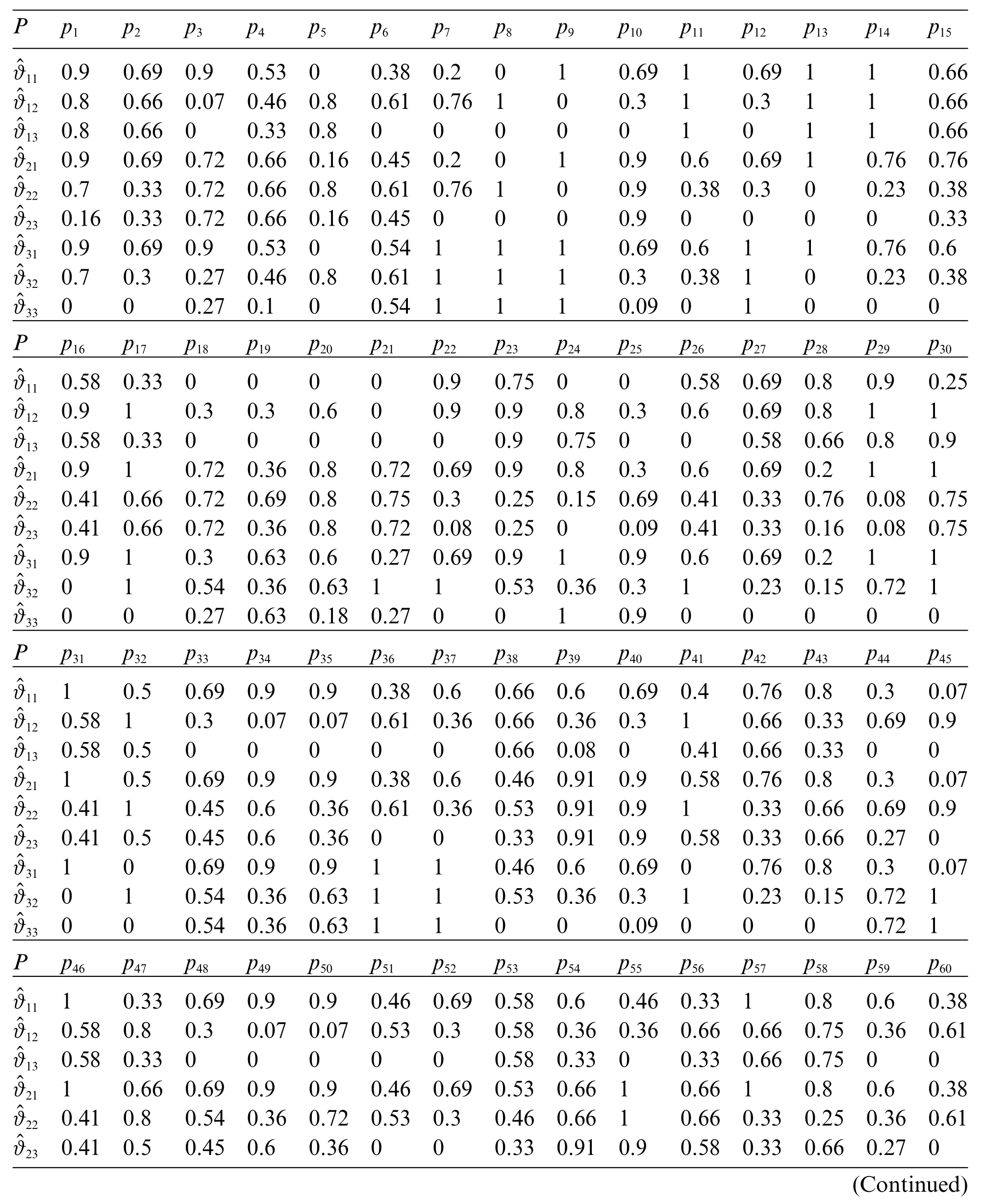
Table 6: or
P p1p2p3p4p5p6p7p8p9p10p11p12p13p14p15 ˆϑ11 0.9 0.69 0.9 0.53 00.38 0.2 010.69 10.69 110.66 ˆϑ12 0.8 0.66 0.07 0.46 0.8 0.61 0.76 100.3 10.3 110.66 ˆϑ13 0.8 0.66 00.33 0.8 0000010110.66 ˆϑ21 0.9 0.69 0.72 0.66 0.16 0.45 0.2 010.9 0.6 0.69 10.76 0.76 ˆϑ22 0.7 0.33 0.72 0.66 0.8 0.61 0.76 100.9 0.38 0.3 00.23 0.38 ˆϑ23 0.16 0.33 0.72 0.66 0.16 0.45 0000.9 00000.33 ˆϑ31 0.9 0.69 0.9 0.53 00.54 1110.69 0.6 110.76 0.6 ˆϑ32 0.7 0.3 0.27 0.46 0.8 0.61 1110.3 0.38 100.23 0.38 ˆϑ33 000.27 0.1 00.54 1110.09 01000 P p16p17p18p19p20p21p22p23p24p25p26p27p28p29p30 ˆϑ11 0.58 0.33 00000.9 0.75 000.58 0.69 0.8 0.9 0.25 ˆϑ12 0.9 10.3 0.3 0.6 00.9 0.9 0.8 0.3 0.6 0.69 0.8 11 ˆϑ13 0.58 0.33 000000.9 0.75 000.58 0.66 0.8 0.9 ˆϑ21 0.9 10.72 0.36 0.8 0.72 0.69 0.9 0.8 0.3 0.6 0.69 0.2 11 ˆϑ22 0.41 0.66 0.72 0.69 0.8 0.75 0.3 0.25 0.15 0.69 0.41 0.33 0.76 0.08 0.75 ˆϑ23 0.41 0.66 0.72 0.36 0.8 0.72 0.08 0.25 00.09 0.41 0.33 0.16 0.08 0.75 ˆϑ31 0.9 10.3 0.63 0.6 0.27 0.69 0.9 10.9 0.6 0.69 0.2 11 ˆϑ32 010.54 0.36 0.63 110.53 0.36 0.3 10.23 0.15 0.72 1 ˆϑ33 000.27 0.63 0.18 0.27 0010.9 00000 P p31p32p33p34p35p36p37p38p39p40p41p42p43p44p45 ˆϑ11 10.5 0.69 0.9 0.9 0.38 0.6 0.66 0.6 0.69 0.4 0.76 0.8 0.3 0.07 ˆϑ12 0.58 10.3 0.07 0.07 0.61 0.36 0.66 0.36 0.3 10.66 0.33 0.69 0.9 ˆϑ13 0.58 0.5 000000.66 0.08 00.41 0.66 0.33 00 ˆϑ21 10.5 0.69 0.9 0.9 0.38 0.6 0.46 0.91 0.9 0.58 0.76 0.8 0.3 0.07 ˆϑ22 0.41 10.45 0.6 0.36 0.61 0.36 0.53 0.91 0.9 10.33 0.66 0.69 0.9 ˆϑ23 0.41 0.5 0.45 0.6 0.36 000.33 0.91 0.9 0.58 0.33 0.66 0.27 0 ˆϑ31 100.69 0.9 0.9 110.46 0.6 0.69 00.76 0.8 0.3 0.07 ˆϑ32 010.54 0.36 0.63 110.53 0.36 0.3 10.23 0.15 0.72 1 ˆϑ33 000.54 0.36 0.63 11000.09 0000.72 1 P p46p47p48p49p50p51p52p53p54p55p56p57p58p59p60 ˆϑ11 10.33 0.69 0.9 0.9 0.46 0.69 0.58 0.6 0.46 0.33 10.8 0.6 0.38 ˆϑ12 0.58 0.8 0.3 0.07 0.07 0.53 0.3 0.58 0.36 0.36 0.66 0.66 0.75 0.36 0.61 ˆϑ13 0.58 0.33 000000.58 0.33 00.33 0.66 0.75 00 ˆϑ21 10.66 0.69 0.9 0.9 0.46 0.69 0.53 0.66 10.66 10.8 0.6 0.38 ˆϑ22 0.41 0.8 0.54 0.36 0.72 0.53 0.3 0.46 0.66 10.66 0.33 0.25 0.36 0.61 ˆϑ23 0.41 0.5 0.45 0.6 0.36 000.33 0.91 0.9 0.58 0.33 0.66 0.27 0(Continued)

Table 6 (continued)
The fourth step:From the third step we can conclude that thirty four patientsp2,p5-p7,p9-p12,p14,p19,p20,p23-p25,p27-p29,p31,p33,p34,p36-p38,p43,p44,p46,p49,p50,p53,andp56-p60have high values ofsi.Therefore,these patients potentially suffer from COVID-19.All values ofsi (i=1,2,3,...,60) and its relationship to sixty patients(p1-p60)are shown in Fig.2 and the diagnosis results are illustrated in Table 7.

Figure 2:The relationship between p1-p60 and si
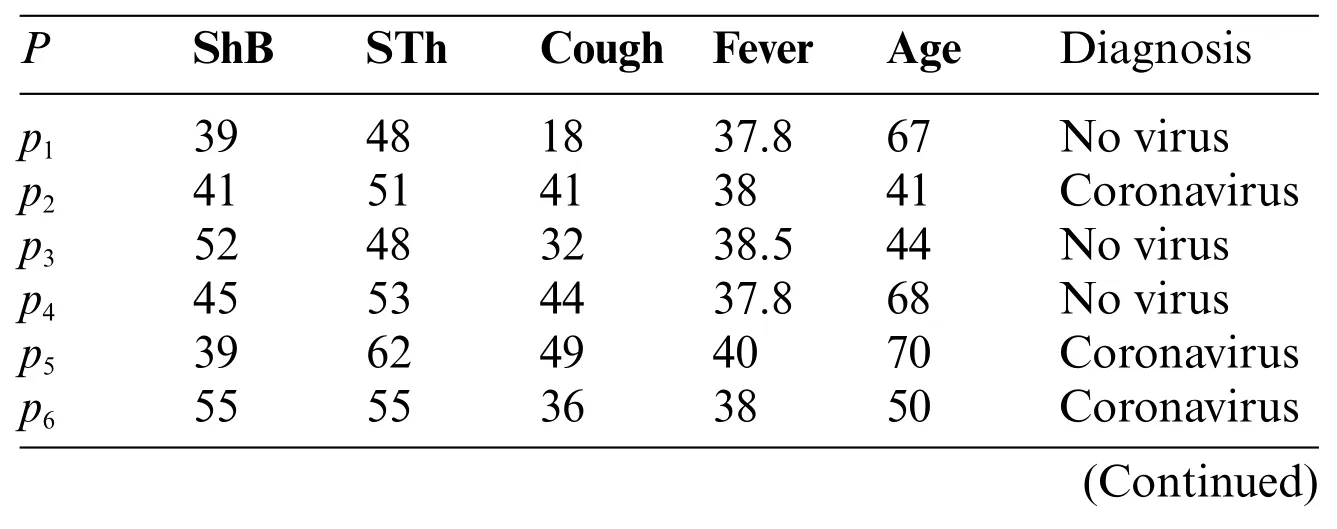
Table 7: Diagnosis results from expert physician
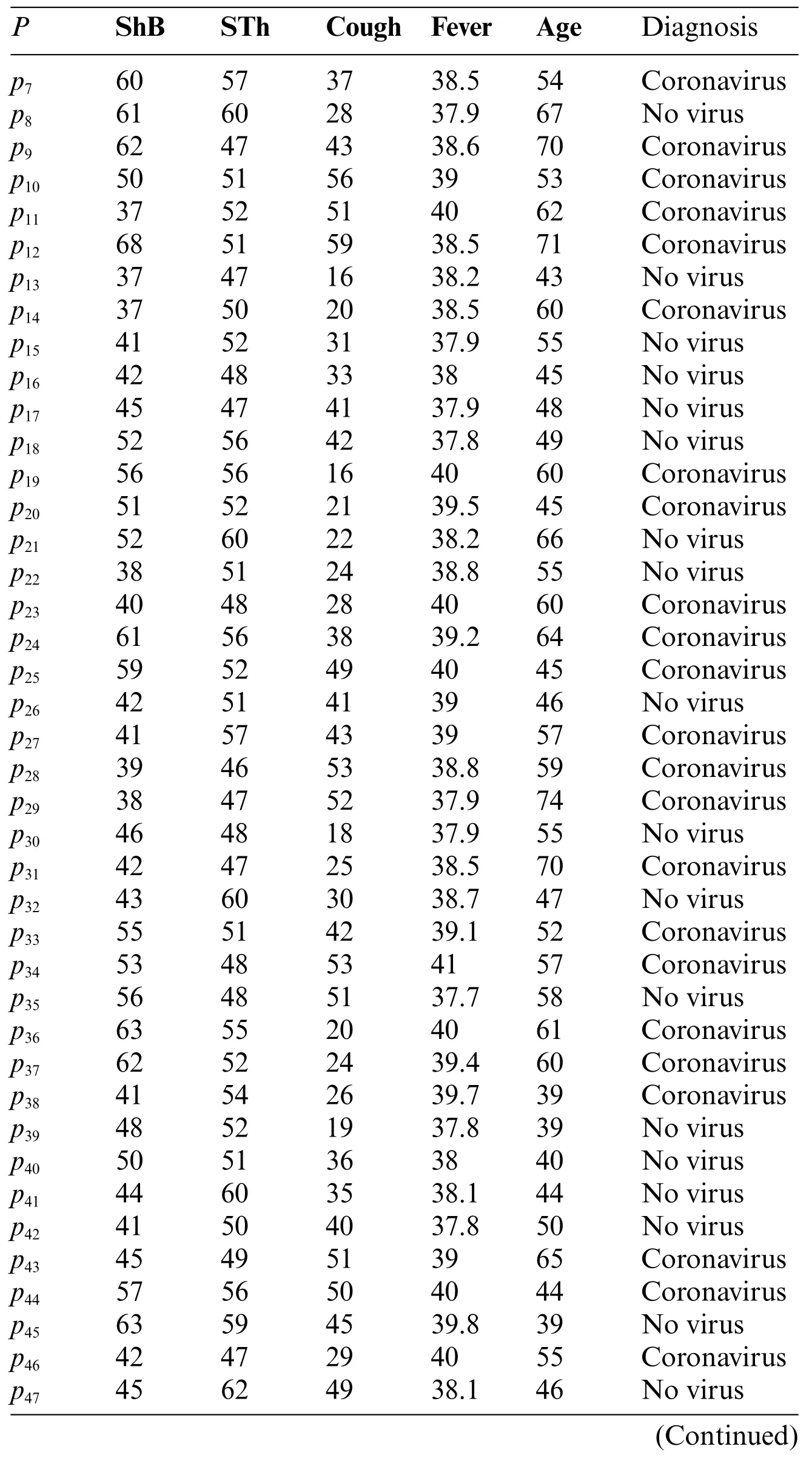
Table 7 (continued)
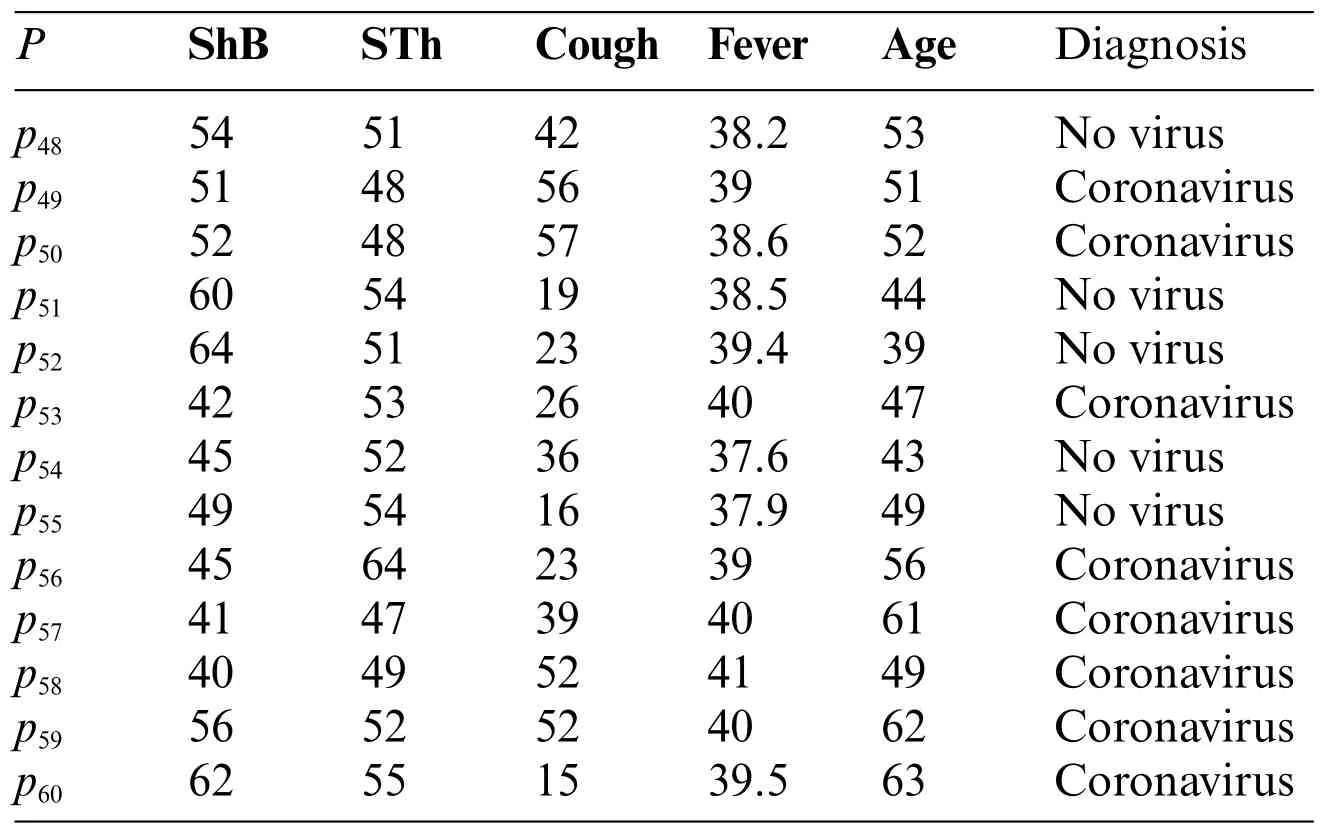
Table 7 (continued)
5 Comparison Among the Fuzzy-Soft Expert System and the Fuzzy Expert System
5.1 Fuzzy Expert System
A fuzzy expert system is one of the known systems used for medical diagnosis.The main structure of the fuzzy expert system is illustrated in Fig.3.
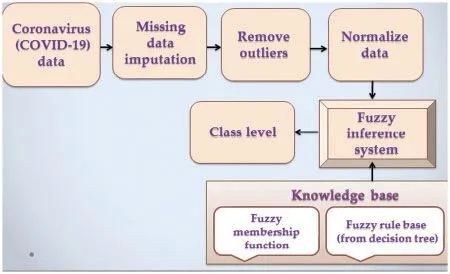
Figure 3:Main structure of the fuzzy expert system
The basic rules of COVID-19 data are inside the fuzzy expert system, though there are several insufficiencies in the above fuzzy expert system of COVID-19.Therefore,
(1)The fuzzy expert system depends on fuzzy rules(i.e.,the input data of ShB have 4 membership functions(L,M,H,VH),the input data of STh have 4 membership functions(L,M,H,VH),the input data of Cough have 4 membership functions(L,M,H,VH),the input data of Fever have 4 membership functions(L,N,M,H),and the input data of Age have 4 membership functions(Y,M,O,VO))which mean 4 × 4 × 4 × 4 × 4 = 1024 fuzzy rules; so the diagnosis results by a fuzzy expert system of COVID-19 according to several groups of fuzzy rules are contrary.For example,
(i)If the patient(p)has ShB(H)and STh(VH)and Cough(H)and Fever(H)and Age(O),thenphave Coronavirus(COVID-19).
(ii)If the same patient(p)has ShB(M)and STh(M)and Cough(L)and Fever(N)and Age(Y),thenpdon’t have Coronavirus(COVID-19).
(2)The diagnosis results by a fuzzy expert system of COVID-19 are contrary to that of an expert physician.
If we apply a fuzzy expert system(according to 1024 fuzzy rules)by using the data from Table 1,then we can note that all the patients have Coronavirus(COVID-19).
According to the above discussion,our proposed system’s diagnosis results(which is the same as the diagnosis results from expert physicians)are better than the diagnosis results from the fuzzy expert system.Therefore,our proposed system(which depends on the approach by Kong et al.[45]for the prediction of COVID-19)is evidence to present a remarkable improvement in the fuzzy expert system.
6 Conclusions
In this work,the fuzzy-soft expert system is better than the fuzzy expert system for the accuracy of diagnosis results.This method of our work is simple because it does not depend on programming software,as well as,unconventional medical analysis methods where the patient suffers from fatigue and the diagnosis appears after a long period of time.This proposed fuzzy-soft expert system will assist physicians and senior researchers who are interested in this emerging virus(COVID-19)in the rapid prediction of this virus diagnosis.Further,there is a study presented that some medical tests such as PCR to detect COVID-19 give inaccurate results[43,46].In contrast,it is possible to use our system for accuracy and ease of implementation.In cooperation with the computer sciences department,the subsequent work will be the establishment of a program in hospitals,centers of diseases,and also at airports to limit the rapid spread of COVID-19 using this system.
Acknowledgement:The authors wish to express their appreciation to the reviewers for their helpful suggestions which greatly improved the presentation of this paper.
Funding Statement:The authors received no specific funding for this study.
Conflicts of Interest:The authors declare that they have no conflicts of interest to report regarding the present study.
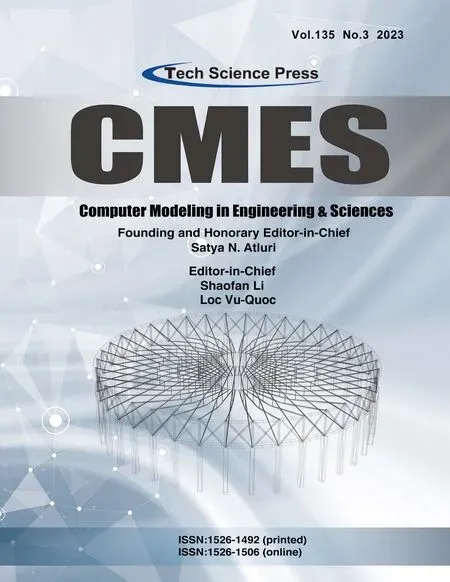 Computer Modeling In Engineering&Sciences2023年6期
Computer Modeling In Engineering&Sciences2023年6期
- Computer Modeling In Engineering&Sciences的其它文章
- Finite Element Implementation of the Exponential Drucker-Prager Plasticity Model for Adhesive Joints
- A Review of Electromagnetic Energy Regenerative Suspension System&Key Technologies
- Arabic Optical Character Recognition:A Review
- Survey on Task Scheduling Optimization Strategy under Multi-Cloud Environment
- A Review of Device-Free Indoor Positioning for Home-Based Care of the Aged:Techniques and Technologies
- Topology Optimization for Harmonic Excitation Structures with Minimum Length Scale Control Using the Discrete Variable Method
